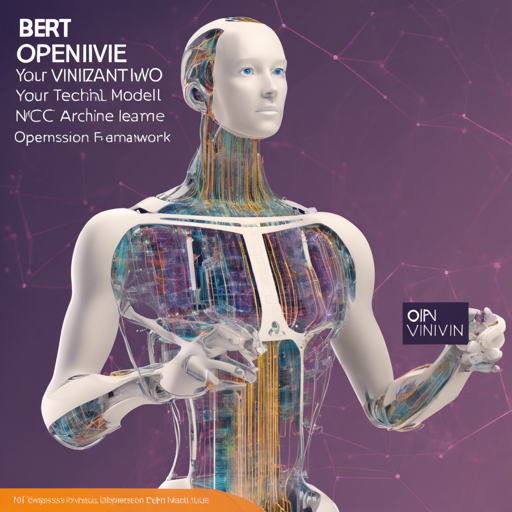Welcome to the world of AI, where optimization can redefine the performance of models. In this article, we will delve into the process of optimizing the vuiseng9/bert-base-squad-v1-pruneofa-90pc-bt model utilizing OpenVINO’s NNCF. We’ll cover step-by-step instructions for setting up your environment, methods for applying optimizations, and how to evaluate the effectiveness of the adaptations.
Step 1: Clone Necessary Repositories
The journey starts by gathering all required tools. Use the following commands to clone the relevant repositories:
bash
git clone https://github.com/vuiseng9/nncf
cd nncf
git checkout tld-poc
git reset --hard 5647610d5ee2bf9f1324604e6579bca1c391e260
python setup.py develop
pip install -r examples/torch/requirements.txt
Step 2: Clone Hugging Face’s nn_pruning Repository
Next, to incorporate pruning techniques, execute these commands:
bash
git clone https://github.com/vuiseng9/nn_pruning
cd nn_pruning
git checkout reproduce-evaluation
git reset --hard 2d4e196d694c465e43e5fbce6c3836d0a60e1446
pip install -e .[dev]
Step 3: Clone the Main Transformers Repository
Finally, we need to get the Hugging Face Transformers library:
bash
git clone https://github.com/vuiseng9/transformers
cd transformers
git checkout tld-poc
git reset --hard 5dd7402e9a316041dea4ff67508c01047323616e
pip install -e .
head -n 1 examples/pytorch/question-answering/requirements.txt | xargs -i pip install
Step 4: Additional Dependencies and Training Setup
Install any additional dependencies required for optimal operation:
bash
pip install onnx
Now you’re ready to start training. Download the necessary configuration files and set paths for the training process:
bash
wget https://huggingface.co/vuiseng9/bert-base-squad-v1-pruneofa-90pc-bt-qat-lt/raw/main/nncf_bert_squad_sparsity.json
NNCF_CFG=path/to/downloaded_nncf_cfg_above # to-revise
OUTROOT=path/to/train_output_root # to-revise
WORKDIR=transformers/examples/pytorch/question-answering # to-revise
RUNID=bert-base-squad-v1-pruneofa-90pc-bt-qat-lt
cd $WORKDIR
OUTDIR=$OUTROOT/$RUNID
mkdir -p $OUTDIR
export CUDA_VISIBLE_DEVICES=0
NEPOCH=5
python run_qa.py \
--model_name_or_path vuiseng9/bert-base-squad-v1-pruneofa-90pc-bt \
--pruneofa_qat \
--dataset_name squad \
--do_eval \
--do_train \
--evaluation_strategy steps \
--eval_steps 250 \
--learning_rate 3e-5 \
--lr_scheduler_type cosine_with_restarts \
--warmup_ratio 0.25 \
--cosine_cycles 1 \
--teacher bert-large-uncased-whole-word-masking-finetuned-squad \
--teacher_ratio 0.9 \
--num_train_epochs $NEPOCH \
--per_device_eval_batch_size 128 \
--per_device_train_batch_size 16 \
--max_seq_length 384 \
--doc_stride 128 \
--save_steps 250 \
--nncf_config $NNCF_CFG \
--logging_steps 1 \
--overwrite_output_dir \
--run_name $RUNID \
--output_dir $OUTDIR
Step 5: Evaluation
After your training concludes, it’s time to evaluate the model’s performance. Follow these steps:
bash
git clone https://huggingface.co/vuiseng9/bert-base-squad-v1-pruneofa-90pc-bt-qat-lt
MODELROOT=path/to/cloned_repo_above # to-revise
export CUDA_VISIBLE_DEVICES=0
OUTDIR=eval-bert-base-squad-v1-pruneofa-90pc-bt-qat-lt
WORKDIR=transformers/examples/pytorch/question-answering # to-revise
cd $WORKDIR
mkdir $OUTDIR
nohup python run_qa.py \
--model_name_or_path vuiseng9/bert-base-squad-v1-pruneofa-90pc-bt \
--dataset_name squad \
--qat_checkpoint $MODELROOT/checkpoint-22000 \
--nncf_config $MODELROOT/nncf_bert_squad_sparsity.json \
--to_onnx $OUTDIR/bert-base-squad-v1-pruneofa-90pc-bt-qat-lt.onnx \
--do_eval \
--per_device_eval_batch_size 128 \
--max_seq_length 384 \
--doc_stride 128 \
--overwrite_output_dir \
--output_dir $OUTDIR | tee $OUTDIR/run.log
Understanding the Code: An Analogy
Think of optimizing your model like fine-tuning a musical instrument. Each step in the setup—cloning repositories, installing dependencies, and running training—is akin to tuning strings, adjusting volume, and perfecting pitches. If one string (dependency) is off, or the instrument (model) isn’t set up correctly, the whole performance (evaluation) may fall flat. Just like a musician regularly checks and adjusts their instrument to perfect their performance, with code, continuous adjustments ensure our models achieve peak performance.
Troubleshooting
During the optimization process, issues may arise. Here are some common problems and their solutions:
- Problem: Installation errors appear while cloning repositories or installing dependencies.
- Solution: Ensure that you have the correct permissions and that your internet connection is stable. Try reinstalling or checking for specific dependency versions.
- Problem: During training, you encounter resource-related errors.
- Solution: Make sure that the specified
CUDA_VISIBLE_DEVICESis properly set up and that your environment has enough memory and processing power. You may also reduce the batch size to lower memory demands.
For more insights, updates, or to collaborate on AI development projects, stay connected with fxis.ai.
At fxis.ai, we believe that such advancements are crucial for the future of AI, as they enable more comprehensive and effective solutions. Our team is continually exploring new methodologies to push the envelope in artificial intelligence, ensuring that our clients benefit from the latest technological innovations.

